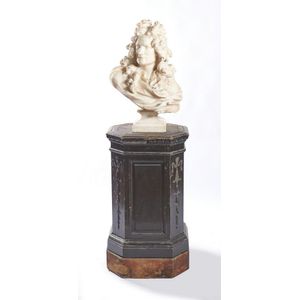Caffieri-inspired Carrara Marble Bust on Ebonised Plinth
After Jean-Jacques Caffieri (French, 1725-1792), Corneille van Cleve (1645-1732), carrara marble, the 19th century bust, naturalistically carved, above a square tapering socle, raised on a canted rectangular ebonised plinth, the bust and socle 70 cm high, 48 cm wide, 25 cm deep, the plinth 90 cm high, 50 cm wide, 41 cm deep. Repair to a section of the figure's nose.
You must be a subscriber, and be logged in to view price and dealer details.
Subscribe Now to view actual auction price for this item
When you subscribe, you have the option of setting the currency in which to display prices to $Au, $US, $NZ or Stg.
This item has been sold, and the description, image and price are for reference purposes only.
- Socle - The short plinth, usually cylindrical, that serves as a pedestal for a sculpture or vase
- Carrara Marble - Carrara marble is a type of white or blue-grey marble quarried in the Carrara region of Tuscany, Italy. It is prized for its beauty, durability and the ease with which it can be worked. The marble has been used for thousands of years for sculptures and architectural details, and was particularly popular during the Renaissance period. Some of the most famous sculptures in the world, such as Michelangelo's David, were carved from Carrara marble. It is also widely used in the construction of buildings, floors, and countertops, both indoors and outdoors. This marble is known for its unique veining which gives it a distinctive look, and it's a popular choice for interior design, especially bathrooms and kitchens.
This item has been included into following indexes:
